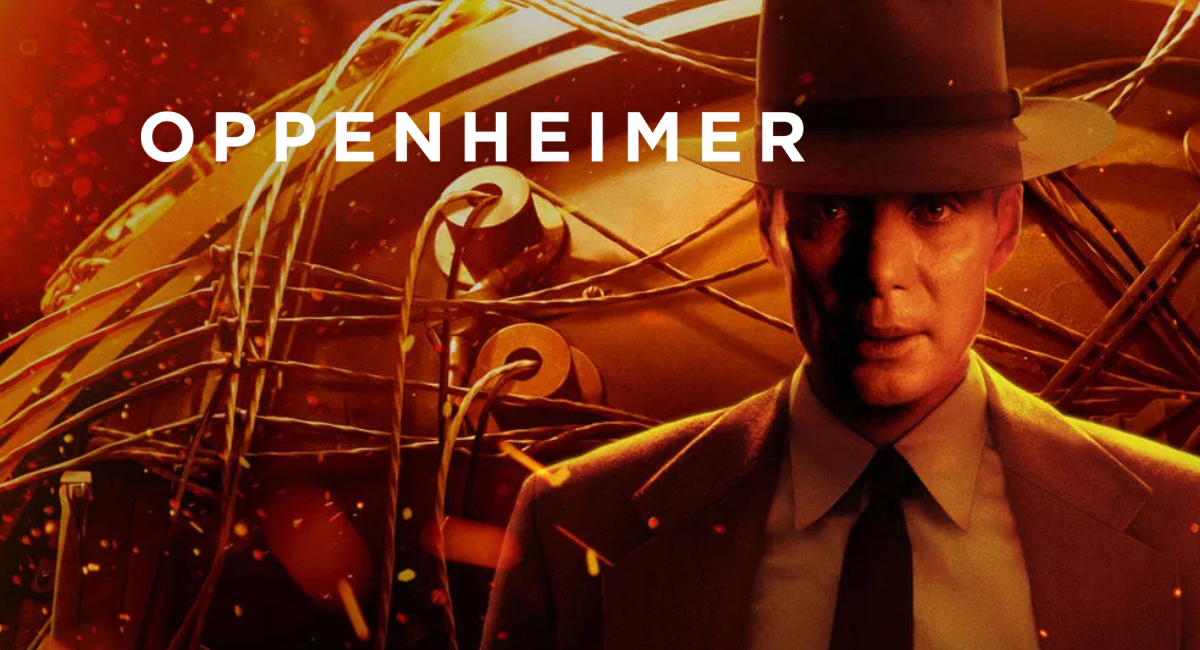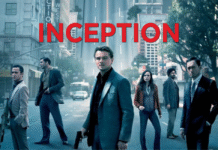Oppenheimer (2023): A Boom Heard Round the World
Christopher Nolan’s Oppenheimer is a film so massive, so intellectually charged and so unapologetically explosive that it makes most modern blockbusters look like a toddler playing with a chemistry set. Forget capes and CGI – this is a movie about a man who literally invented the end of the world. And somehow, Nolan made it riveting, exhausting and at times, existentially hilarious. Welcome to Oppenheimer, the feel-bad hit of the summer.
Cillian Murphy stars as J. Robert Oppenheimer, the theoretical physicist and tortured soul behind the Manhattan Project. You may know him as the guy who built the atomic bomb. Or as the bloke who gave humanity the ability to incinerate itself. But here, he’s Nolan’s philosophical action hero, battling quantum mechanics, guilt and an ensemble cast so stacked it makes The Avengers look like jury duty.
Table of Contents
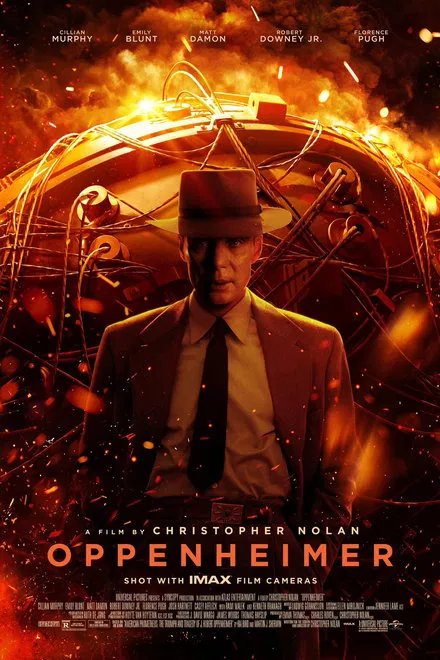
The Origins of Doom (a.k.a. Physics is Sexy Now)
The first hour is all kaleidoscopic timelines and rapid-fire jargon that makes you feel like you accidentally walked into a physics lecture. Nolan, as ever, assumes his audience has the IQ of a Mensa recruiter and the patience of a Buddhist monk. Luckily, Murphy holds it all together with cheekbones so sharp they could split atoms.
We follow young Oppie as he bounces between Harvard, Cambridge and Berkeley, dropping knowledge, seducing women and staring pensively into the void. Emily Blunt plays his long-suffering wife Kitty with the expression of someone who just realised she married a man emotionally married to uranium. Florence Pugh shows up as Jean Tatlock, Oppenheimer’s communist lover and delivers what can only be described as the most intellectually charged nudity in cinematic history. Yes, they’re naked. Yes, they’re quoting Sanskrit. Because of course they are.
Los Alamos – The World’s Worst Summer Camp
Welcome to Los Alamos, New Mexico. Home of sand, scorpions and apocalyptic science. Oppenheimer assembles a nerdy Avengers team to build a bomb before the Nazis do. It’s a real-life episode of The Apprentice, only instead of selling advertising, the contestants are figuring out how to end civilisation.
Matt Damon plays General Leslie Groves with all the subtlety of a sledgehammer. He’s the military man trying to wrangle the world’s most emotionally unstable collection of geniuses. Think Big Bang Theory if it were written by Kafka.
There’s something inherently absurd about watching a bunch of sweaty physicists agonising over equations that will vaporise entire cities. Nolan leans into this contradiction, occasionally flirting with humour so dry it could be used to soak up hydrogen isotopes.
The Trinity Test: Boom Goes the Existential Dread
And then comes the moment. The Big Bang. The Trinity Test.
Shot in IMAX, devoid of CGI and orchestrated with all the subtlety of a symphonic panic attack, the bomb’s detonation is pure cinematic cataclysm. There’s no music. Just the silent flash, followed by a gut-punch of sound so delayed it feels like God himself is loading.
This is Nolan at his most powerful and most terrifying. It’s not just spectacle; it’s a spiritual crisis on celluloid. As the light blooms and the fire consumes the horizon, you can almost hear Oppie’s internal monologue scream: “What have I done?” Or maybe it’s just Nolan shouting at the audience, “I told you science was dramatic!”
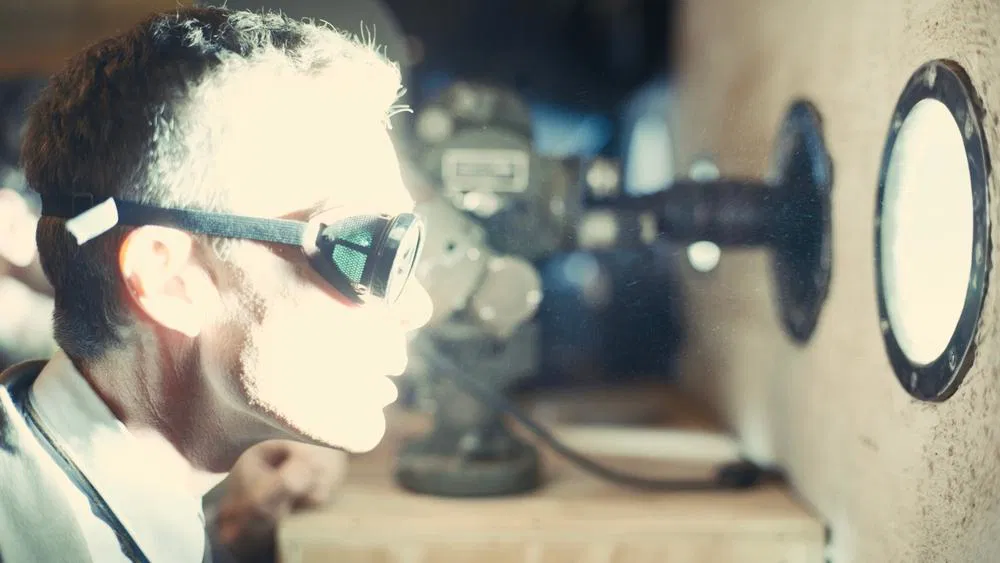
Guilt, Paranoia and a Senate Hearing for the Ages
You’d think that after creating a weapon that turned Hiroshima into a nightmare, things might quiet down. But no. Oppenheimer’s reward for atomic wizardry is betrayal, political exile and a soul so burdened with remorse it makes Hamlet look well-adjusted.
Enter Robert Downey Jr. as Lewis Strauss, the bureaucratic snake with a smile so fake it might be AI-generated. Downey dials it down brilliantly, playing Strauss as a man whose ego is only eclipsed by his pettiness. The scenes between him and Oppenheimer are a bureaucratic cage match wrapped in moral ambiguity.
The third act transforms into a political thriller with the emotional weight of a Greek tragedy. As the government turns on its once-revered genius, the film becomes less about bombs and more about consequences – personal, political and philosophical. It’s like watching Einstein weep into a Freedom of Information Act request.
The Cast: A Physicist’s Guide to Awards Season
Cillian Murphy is nothing short of transcendent. He doesn’t just play Oppenheimer; he becomes him – haunted, brilliant and slightly terrifying. Expect Oscar buzz so loud it might trigger a Geiger counter.
Emily Blunt finally gets a moment to unleash the fury, delivering a scene in a Senate hearing that could melt titanium. Florence Pugh, while underused, adds depth to Tatlock that transcends the typical “tragic mistress” role. And Downey Jr.? He proves that Iron Man was just foreplay.
Even the supporting cast – Rami Malek, Benny Safdie, Josh Hartnett – manage to leave an impression. It’s like a cinematic physics department staff meeting where everyone’s won a BAFTA.
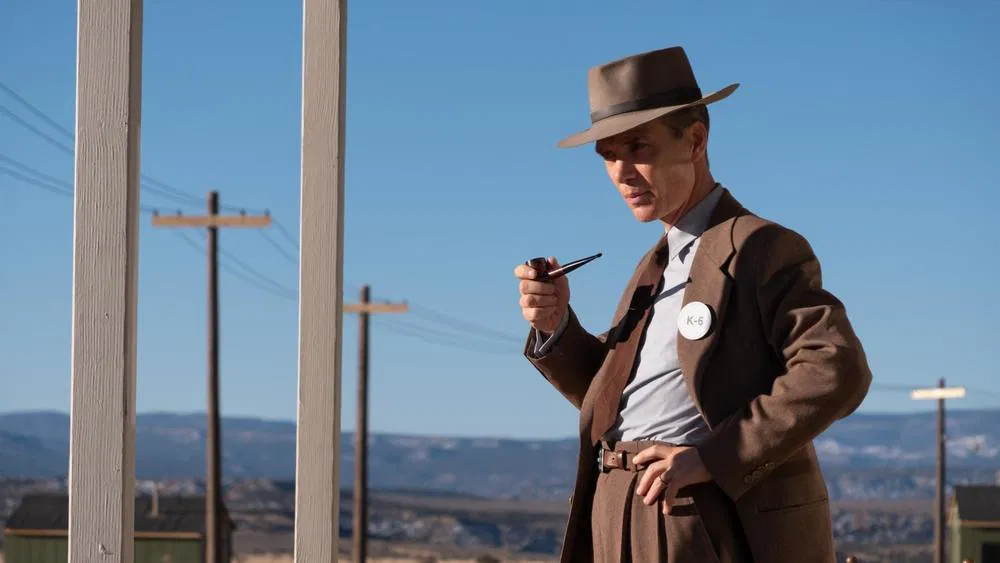
Nolan’s Style: Time, Trauma and Ticking Clocks
This is Nolan’s most restrained film, and that’s saying something. Yes, there’s the signature non-linear narrative, the multiple timelines and the emotionally repressed men who express feelings by glaring at chalkboards. But here, the chaos serves the story.
Ludwig Göransson’s score is a pulsing, almost biological presence, humming with dread and urgency. Hoyte van Hoytema’s cinematography captures both the vast emptiness of the desert and the claustrophobic intensity of Oppenheimer’s conscience.
And, mercifully, there’s no dead wife in a fridge this time. Just living ones who wish they were.
Historical Accuracy: Close Enough for Government Work
Is it 100% accurate? Of course not. This is a Nolan film, not a History Channel documentary. But the essence is there. Oppenheimer’s contradictions, his genius, his guilt – all of it feels emotionally authentic, even if a few facts are fudged.
Yes, the film simplifies some scientific debates. Yes, it compresses timelines. Yes, it makes Oppenheimer look like the Patron Saint of Nuclear Anxiety. But that’s because Nolan isn’t interested in dry accuracy. He’s aiming for myth.
And Oppenheimer is exactly that: a mythologised account of a man who gave humanity its deadliest tool and then spent the rest of his life trying to stuff the radioactive genie back in the bottle.
Trivia: Things That Didn’t Make the Blast Radius
- Cillian Murphy reportedly lost a significant amount of weight to match Oppenheimer’s gaunt frame, consuming little more than air, regret and Nobel Prize nominations.
- The explosion in the Trinity Test scene was created without CGI. Nolan, like Oppenheimer, prefers his detonations practical and terrifying.
- Albert Einstein does make a cameo. No, he doesn’t drop any bombs – but his hat game is strong.
My Final Thoughts: Bombshell Cinema
Oppenheimer isn’t just a film. It’s an event. A dense, brilliant, soul-scouring epic that refuses to offer easy answers or tidy resolutions. It’s a film that demands attention, patience and perhaps a stiff drink afterwards.
It’s not perfect. It’s too long. It’s occasionally up its own subatomic backside. But it’s also unforgettable – like being trapped inside a very stylish panic attack narrated by Werner Heisenberg.
In a cinematic landscape awash with mediocrity, Oppenheimer is a thunderclap. A film about the man who made the bomb, crafted by a director who drops cinematic bombs for a living.

If You Like Oppenheimer, I Recommend These Movies:
- There Will Be Blood (2007): Ambition, oil and milkshake metaphors. Now with extra misanthropy.
- The Social Network (2010): Swap physics for coding, but keep the self-destruction.
- Fat Man and Little Boy (1989): Another take on the Manhattan Project, minus the Nolanisms and prestige gloss.

Oppenheimer
J. Robert Oppenheimer
Kitty Oppenheimer
Leslie Groves
Lewis Strauss
Jean Tatlock
Ernest Lawrence
Boris Pash
David Hill



